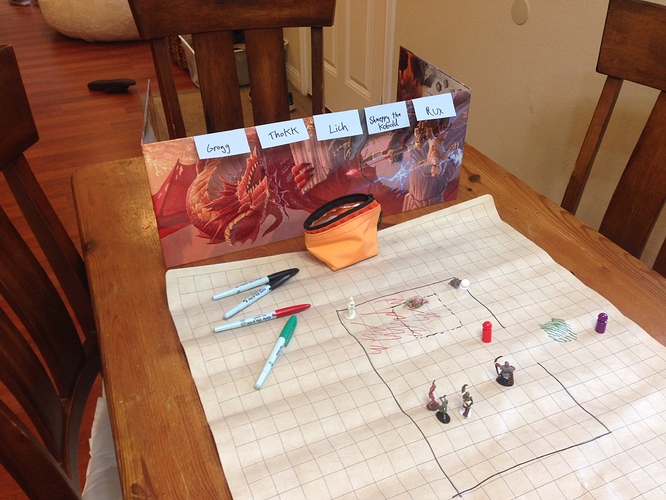If you’re considering submitting a feature request, I encourage you to read through this post. Whether or not your feature is implemented is determined (mostly) by how well it aligns with the traits laid out here.
The Disconnect in the World of Virtual Tabletops
Most virtual tabletops try to provide a “high-detail visual experience,” ie: they expect GMs to build (or use) detailed maps and tokens.
This doesn’t match up with most of the in-person games I’ve been in where I’ve mostly used wet-erase mats and abstract (or mismatched) tokens instead:
Printed-out maps or beautiful dioramas still appear, but they’re the exception because they’re a lot more work.
I think this disconnect is why many groups who’ve brought their games online end up playing without any maps or imagery. They tried to bring their game as-they-play-it online and were instead encouraged to substantially change how they play.
Staying Authentic
Shmeppy tries to fix this disconnect and stay authentic to the wet-erase mat experience.
This is easier said than done. Most GMs don’t have a stylus so Shmeppy can’t just provide a shared MS Paint-like drawing surface and call it a day. Instead I’ve had to think about the important traits of a wet-erase mat and build a tool that has those same traits. I’ve come up with three.
The Three Traits
Both wet-erase mats and Shmeppy’s drawing surface have these three traits:
- Drawing a map takes almost no time
- Getting started takes moments, even if you’ve never used it
- You’re encouraged to stay abstract: no fine details
Let’s dive into each of them.
Drawing a map takes almost no time
This is the most important trait.
Being able to make a map in less than a minute is exactly why I love wet-erase mats and is exactly why I’ve been frustrated with every other virtual tabletop I’ve used.
Some play styles aren’t even supported without this, in particular: improvised games where the GM doesn’t know where the players will be and draws the maps during the session.
Getting started takes moments, even if you've never used it
This is the second most important trait.
Tabletop gaming online should be easily accessible. Not reserved to those who’re willing to spend hours reading tutorial content.
Most virtual tabletops do not satisfy this. There’s hours of tutorial content for all of the most popular solutions out there. I think Shmeppy’s ease-of-use will be a serious competitive advantage.
You're encouraged to stay abstract: no fine details
This is the third most important trait.
First, the phenomonon this trait is based on… If you give someone a big chunky marker and a whiteboard then ask them to draw a duck, they will (probably) sketch a duck quickly. If you instead give them a set of paint brushes and a canvas then ask them to draw a duck, they will (probably) spend way longer trying to make a good painting. Because I don’t know what this phenomon is actually called, I call it “The Painted Duck Effect.”
Because of The Painted Duck Effect, accomplishing the first trait (quick drawing) is almost impossible without also accomplishing this trait. They are extricably tied together.
So this trait is not important on its own. If I could create a tool that lets users create high-detail maps without losing out on ease-of-use and speed (the first two traits), I would. But I can’t, therefore this trait is important.
Brutal Focus
Since I’ve started building Shmeppy I’ve received hundreds of feature requests and I’ve rejected or side-lined any feature that would compromise Shmeppy’s ability to satisfy these three traits. This has ended up being most features.
When a feature is in a gray area and doesn’t substantially compromise a trait and would be super useful to have, some careful thinking is required.
I’m looking forward to seeing ya’ll’s feature requests and thoughts in this forum, and I hope sharing these traits with ya’ll will help us talk about Shmeppy’s future in a way that feels good for everyone.
–
I’d love to hear your questions or thoughts about these traits, as well as how effectively I’ve presented them in this post.

